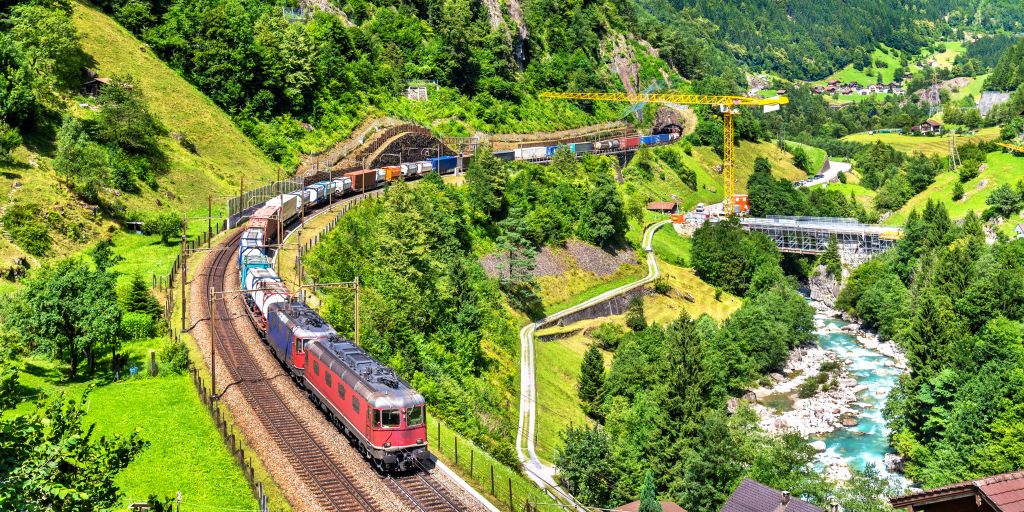Swiss technology at its best: Switzerland made history in 2016 with the opening of the new Gotthard Tunnel – the longest railway tunnel in the world.
The basics in a nutshell
- The new Gotthard Tunnel took 17 years to build.
- A total of 12.2 billion francs were invested in the Alpine Tunnel.
57 kilometres: This is the length of the new Gotthard Tunnel. When it opened in 2016, Switzerland made technology history. The new Gotthard Base Tunnel is the longest railway tunnel in the world.
It is part of the New Alpine Railway (NRLA), through which Switzerland wants to shift more freight transport to rail.
This is the story of the Gotthard Tunnel
For centuries, travelers between southern and central Europe had no other choice but to cross the Alps through the mountains. This was done on foot, with herd animals, or in a sleigh. The only other option was to take a long sea voyage from the North Sea across the Atlantic to the Mediterranean.
This changed in the mid-19th century with the expansion of railways in Europe. The idea of constructing a railway tunnel through the Alps arose early.
In 1863 the decision was made to build a tunnel through the Gotthard Block because it was the shortest route. Construction work began in 1872 of Airolo TI in the south and Göschenen UR in the north at the same time, and the breakthrough took place in 1880. Then this Swiss technology attracted more and more tourists.
Opinion poll
Have you ever driven through the Gotthard Tunnel?
At 15 kilometers long, the Gotthard I Tunnel was the longest tunnel in the world at that time. It revolutionized long-distance transportation in Europe. Only a few years after its opening, 32 trains were passing through the tunnel daily, and in 1960 there were 197 trains.
Swiss technology: Gotthard Road Tunnel
The Gotthard Road Tunnel was only opened to car traffic in 1980 after ten years of construction. To date, with a length of 16.9 kilometers, this is the longest road tunnel in the Alps and the fourth longest road tunnel in the world. This eliminated the need to load cars onto special trains to cross the Gotthard Tunnel.
Today it is one of the busiest roads in the Alps and is the most important north-south connection in Switzerland. It is used by about five million cars and 900,000 trucks every year.
For many years there has been debate in Switzerland about building a second tube, which will be put into operation in 2029. The original tube could then be refurbished.
The Federal Roads Office (Astra) also reported on the Swiss technology: “After the renovation of the existing tunnel, traffic can be directed through the Gotthard in single-lane traffic with a side shoulder.”
This is the new Gotthard base tunnel
In 1994, the Federal People's Initiative “For the Protection of the Alpine Area from Transit Traffic” was launched and adopted. It should protect cantons particularly affected by the movement of heavy goods and enforce the diversion of transit traffic to railways.
The result was the construction of a new 57 km tunnel through the Gotthard massif. Its aim was to relieve pressure on the old Gotthard Tunnel.
Swiss technology now enables completely different construction methods. This in turn makes it possible to run heavier and longer freight trains at higher speeds.
For comparison: The Old Gotthard Road has a total length of 30 kilometers and an altitude of 1,151 metres. Here two locomotives can pull freight trains with a maximum weight of 1,400 tons. The height of the new Gotthard line is only 549 metres, and can accommodate trains with a total weight of 4,000 tons.
But it's not just freight transport that benefits from the new Gotthard base tunnel: for passengers, the train journey between Zurich and Lugano TI is shortened by 45 minutes to less than two hours.

“Certified tv guru. Reader. Professional writer. Avid introvert. Extreme pop culture buff.”







More Stories
Samsung Quantum Dot TV: Art meets technology
Pitch: €56m for energy startup Reverion
Plastoplan: Plastics for Energy Transition